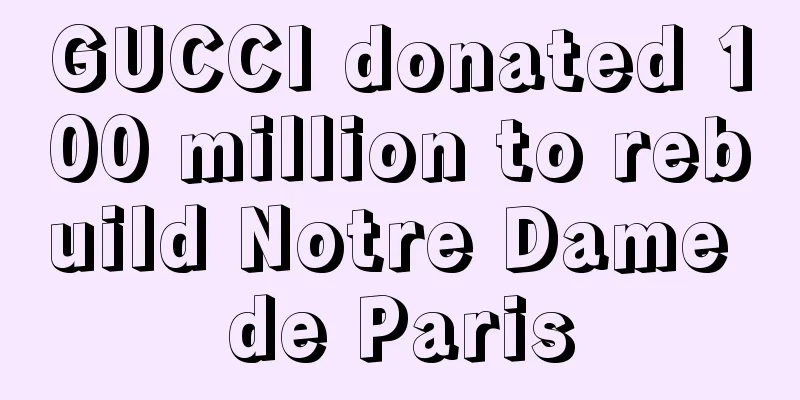GUCCI donated 100 million to rebuild Notre Dame de Paris

|
Introduction: Once upon a time, people prayed in Notre Dame de Paris. Now, it is people's turn to pray for Notre Dame de Paris. At 6:30 pm on April 15, 2019, Paris time, a fire swept through Notre Dame de Paris, and thick smoke enveloped the entire Paris. Thousands of French people watched Notre Dame de Paris in tears, and countless netizens around the world sat in front of their computers and prayed for Notre Dame de Paris. When disaster strikes, no man is an island. The fire at Notre Dame de Paris is not only a disaster for the French people, but also a tragedy for human civilization. In order to rebuild Notre Dame de Paris, French President Macron announced on Twitter that he would launch an international fundraising campaign, calling on people from all over the world to donate to the reconstruction of Notre Dame de Paris. Kering Group, which owns many international first-line luxury brands such as Gucci and YSL, took the lead in announcing that it would donate 100 million euros for the reconstruction of Notre Dame de Paris. This news was like a deep-water torpedo, quickly causing an uproar in public opinion. Old Pitt has always been a famous philanthropist and collector, and it is understandable that he was generous out of regret for the destruction of civilization. But at this time, another French luxury giant LVMH was not willing to lag behind and announced to the public that it was willing to invest 200 million euros to repair Notre Dame de Paris. "Notre Dame has become a symbol of France because of the heritage it represents and the spirit of French solidarity behind it," said the CEO of LVMH Group. The two luxury giants have spent huge sums of money on the restoration of Notre Dame de Paris. Is it because they are deeply saddened by the destruction of civilization, or do they want to take advantage of the opportunity to catch a wave of "hot spots" and rise up with this trend to do free advertising? The author believes that both reasons are true, and even from the perspective of building a brand image, GUCCI's 100 million yuan investment is worth it. The famous "Father of Advertising" Ogilvy once said: " What determines a brand's market position is the brand's own image, not the insignificant differences between products . " When product competition comes to an end, it becomes difficult to distinguish between quality and price, and what ultimately determines the success or failure of a brand is actually the word "image". Only the power of culture and values can transcend the torrent of time, stand tall on the fierce battlefield, and become an indestructible monument. In the fierce market competition, how to successfully build and promote brand image is a question we should think about. Kering Group's performance in this battle is textbook-like, with its lavish spending of 100 million to restore Notre Dame de Paris being a good example. Let us take a look at the success of GUCCI's brand image construction and promotion this time. 1. Focus on building corporate image There is a famous Chinese idiom – “Love the house and love the crow on it”. When you fall in love with someone, even the ugly crow in front of his roof becomes cute. There is a similar term in psychology called the "halo effect" , which means that when a person or a group leaves a good impression on others because of a certain characteristic, people will have a good impression of them and beautify other characteristics of this person or group. Similarly, when a company leaves a relatively good impression on people, people will also be more inclined to favor its sub-brands. The two luxury giants spent huge sums of money to save Notre Dame de Paris because they are well aware of the "halo effect". When a company has a beautiful halo on its head, how can its brands not be stained with glory? Corporate donations are beneficial to establishing corporate image, enhancing corporate social responsibility and public identification with the company, and can also enhance public recognition of its brand, which helps build the brand image. According to the 2018 Forbes Chinese version of the China Charity List, the total amount of donations from China in 2018 reached 17.31 billion yuan. Among them, Evergrande Chairman Xu Jiayin, Midea's He Xiangjian family, and Ruihua Holdings Chairman Zhang Jianbin all donated more than 1 billion yuan within a year, occupying the top three spots on the list. Xu Jiayin, chairman of Evergrande Group, stood out from the crowd with his extremely high donation amount of 4.21 billion yuan. Corporate donations are not only a way for companies to give back to society, but also a display of corporate social responsibility. They are a product that takes into account both benefits and value, and can bring about a series of positive chain reactions for the development of the company. A successful fundraising not only helps solve social problems, but also serves as free publicity, which wins the public's favor. A successful corporate image is closely related to its brand image. If the corporate image is the "root", then the brand image is the "branches and leaves". Only by watering and fertilizing the "trunk" regularly can the tree become "luxuriant and leafy". 2. Take advantage of the “hotspot” "Riding on the wave of popularity" has long been a little trick that every marketer knows tacitly. The information revolution has swept the world, subverting people's lives and bringing about an explosion and flood of information. Junk information and fragmented information are flooding people's lives, and "attention" has become a scarce resource . The "attention economy" means that whoever can attract consumers' attention will win the battle. This is an era of highly scattered attention, but it is also an era of highly concentrated attention. People's attention is only focused on one or two explosive hot spots at the moment. If you want to attract users' attention, you must follow the trend and catch the express train of "hot spots". From a cultural perspective, the fire at Notre Dame de Paris was a tragedy in human history and a cultural elegy. However, it is also the biggest hotspot in recent times. Notre Dame de Paris remained at the top of the trending searches on Weibo for three consecutive days. It was not only followed up and reported by domestic mainstream media such as CCTV, Xinhuanet, and the Beijing News, but also attracted the attention of media around the world. In this context, any information related to Notre Dame de Paris will be constantly amplified, automatically spread by the media and the public, and spread among the crowd like a virus. Spend 100 million euros on a global advertisement and let all official media spontaneously publicize and report on it. You ask me if it’s worth it, yes! 3. Promotional strategy that matches the product image Kering has an indelible relationship with French culture. Rooted in France, Kering Group is deeply influenced by the romantic and passionate French culture and the fashionable and avant-garde French trends. Kering Group was founded by the French Pitt family and became a luxury giant by acquiring major luxury brands. The acquired brands such as GUCCI and YSL are also deeply influenced by its culture. Not long ago, GUCCI also held a fashion show "Paying Tribute to French Culture". Now, France is in trouble, Paris is in trouble, how can Kering Group not take action? Kering Group's brands also reflect distinct French characteristics. GUCCI has always been famous for its "romance" and "retro" in the fashion industry, YSL has long been able to stand firm in the beauty industry because of its "fashion" and "refinement", and Puma is also loved by young people for its youthful and diverse designs. Whether it is advocating the seemingly anti-fashion "retro" trend, or being a fashion leader at the forefront of the times. All brands under Kering Group embody two words: "pioneer". "Avant-garde" has always been a characteristic of French culture, and Notre Dame de Paris is a famous cultural symbol of France. Kering Group, which is deeply influenced by French culture, is raising funds for Notre Dame de Paris, a symbol of French culture. The combination of the two is reasonable and can create a publicity effect where one plus one is greater than two. Fundraising is a means of public welfare, but it can also be a form of publicity. If Kering Group raises funds for "poverty alleviation" or "environmental protection", we will also praise its noble character, but because it is inconsistent with the product image, the publicity effect will not be that great. 4. Brand image promotion with minimal risk The construction and promotion of brand image is like a double-edged sword. If used well, it can help you kill the enemy in one fell swoop. But if used poorly, it can hurt yourself. Any kind of publicity has its drawbacks. "Viral" marketing can easily steal the show, "embedded" marketing can easily bore consumers, and even the "creative" marketing that is so popular among emerging advertisers has the limitation of a small audience. No matter how many things are broken, the only thing that cannot be broken is "doing good deeds". Learn from Lei Feng and do good deeds. There is nothing wrong with donating money to Notre Dame de Paris. Even if some people accuse Kering Group of "riding on the popularity" for marketing, they will be met with sharp gazes from the public. After all, not everyone can come up with one hundred million easily. Kering is not the first brand to achieve great publicity in fundraising, nor will it be the last. In 2008, the Wenchuan earthquake touched the hearts of the entire country. At this time, Wanglaoji made the Jiaduobao Group famous with an extremely high donation of 100 million yuan. Netizens were deeply moved, and there was even a comment on Tianya: "Wang Laoji, you are so ruthless! Donating 100 million yuan is 500 times more than Wang Shi! In order to rectify this arrogant company, buy up all the Wang Laoji in the supermarket! Buy a can every time you can!" Wanglaoji's move not only provided timely assistance to Wenchuan, but also brought success to itself. Surprisingly, this “do good” publicity strategy has resulted in very little market backlash. Compared to Rio, which forcibly opened up the market by inserting advertisements in TV dramas, but suffered from insufficient stamina and market weakness, Wanglaoji, also a beverage brand, did not attract the dislike of consumers. This kind of publicity through "doing good deeds" can achieve personal success while helping others, so why not do it? 5. Create Lenovo and deepen brand value To understand how brand value is established, we must first understand who establishes the brand value. In the commodity-dominated era, consumers were merely passive recipients of corporate values and products. In the consumer-driven era, the value of a brand is jointly built by companies and consumers. This is the latest theory of “value co-creation” proposed by academia. Fierce market competition and extremely abundant material conditions require companies to incorporate consumer experience into the construction of brand value. Simply put, the connotation of your brand value is not important; what is important is how consumers understand your brand. To a certain extent, the era of merchants "boasting about themselves" has ended. Consumers have stepped onto the stage of the times, and the value of brands is created by consumers. What kind of brand value does Kering Group create in this fundraising? Paris is a miracle in the history of world civilization, with profound historical imprints and enduring cultural connotations. To a certain extent, Kering Group's fundraising for Notre Dame de Paris is to "link" its own brands with the culture represented by Notre Dame de Paris, giving the brands a cultural imprint. When we mention GUCCI, we will remember that it spent 100 million on Notre Dame de Paris. How can we not think of the cultural significance behind it? Creating associations is a common means of brand operation. 999 Cold Relief uses the slogan "Warm and caring" to establish an association between cold medicine and "warmth", weakening the connection between "being sick" and "taking medicine". This advertisement was once very popular and greatly boosted the sales of 999 Cold Remedy. Kering Group’s move is more sophisticated and more “high-end” than 999 Group’s. It is true that most of the brands under Kering Group have a long history, but if they are compared with the culture of Notre Dame de Paris, it will only be a laughing stock. But what if you could establish a brand connection with Notre Dame by raising funds to build it? Consumers will only praise it for its noble character. When Notre Dame de Paris was rebuilt and reopened to the public, many consumers who visited it would recall Kering's donation. This is a really clever move! Notre Dame de Paris' long history, tortuous development, past glory, current disaster and future revival are all associated with some brands and a company. Is there any brand value that is more profound and meaningful than this? Some suggestions for brand image building and promotion: The CEO of Coca-Cola once said that even if all Coca-Cola producers in the world were reduced to ashes overnight, there would be many international consortiums lining up to help Coca-Cola rebuild. This is the power of brand image, this is the value of brand image. From GUCCI’s 100 million euro reconstruction of Notre Dame de Paris, we learned that if we want to successfully build and promote our brand image, we have the following suggestions: 1. Pay attention to product positioning and brand positioning, and choose the appropriate brand strategy. 2. Develop appropriate publicity strategies to avoid the risk of market backlash. 3. Focus on building the core value of the brand to ensure that the brand can last forever. 4. Focus on consumer experience and let consumers create the brand image. Conclusion: "Quasimodo lost his beloved girl, and eventually lost his beloved bell tower," the crowd sighed. The fire at Notre Dame de Paris was a disaster in the history of world civilization. The donation of 100 million by GUCCI's parent company, Kering Group, for its reconstruction is worthy of our praise, but there are also many marketing tricks hidden behind it for brand image building and promotion. We appreciate the generosity of all donors and we pray that Notre Dame can return to its former glory. Author: Fang Yun Source: PR Home |
<<: Interior design construction process video tutorial
>>: 11 hot-selling title routines in new media operations, all practical information!
Recommend
Young people's first car should be sporty, fashionable and economical. Emgrand GS can satisfy you.
Nowadays, more and more young people have entered...
Consumer Reports: Japanese brands take the top five spots in the US used car brand reliability ranking, while American brands rank last
The famous American magazine Consumer Reports rec...
3 tips for paid APP promotion!
Last year, I had an interesting work experience. ...
In 2021, all brands need to start over from 0 to 1
Last year was a very special year for all of us. ...
A comprehensive summary of Android application publishing platforms!
During the development process, you may encounter...
Why are you wearing woolen pants under your skirt? Do other kids wear them like this?
Oh no, no, the wind lifted up the skirt of "...
Can O2O in the beauty industry revolutionize female consumption?
The life service industry is being changed by O2O...
After the crash of B Station, A Station also crashed! Official response: It has been fixed
On the evening of July 13, the Weibo topic "...
Weibo marketing promotion strategy, share these 3 points!
Weibo may not bring direct sales, but it can subt...
Android modularization exploration and practice
Preface Tim Berners-Lee, the inventor of the Worl...
Android 12 is here! Check out the Android 12 preview for hands-on experience
Recently, Google suddenly released the Android 12...
China Automobile Dealers Association: Shanghai Automobile Market Registration Situation and Shanghai Market Consumption Characteristics in November 2018
The total number of license plates in Shanghai in...
How to become an excellent user growth operator
As a front-line user growth practitioner, what qu...
The dishes you must not forget to eat in autumn are suitable for weight loss and sugar control
When it comes to beautiful vegetables in autumn, ...









